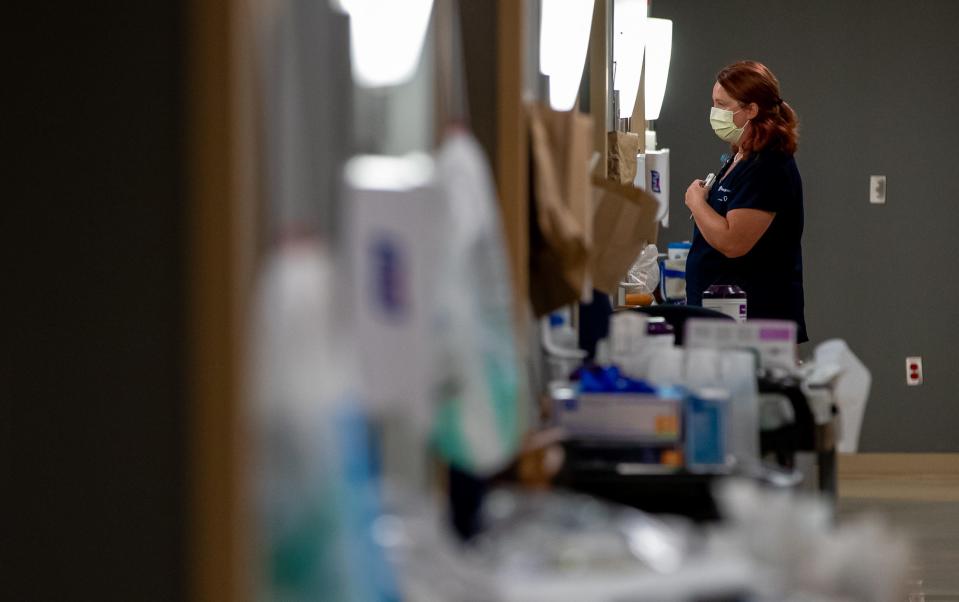'Hurting pretty badly': Hospitals report financial struggles following pandemic.
The past year has proven more taxing financially than any in recent memory for the Good Samaritan Hospital in Vincennes, pushing hospital leaders to consider whether they will discontinue certain types of care.
Rising prices for drugs and supplies as well as skyrocketing costs for health care labor, particularly nurses, are squeezing the 158-bed county hospital, which this year has seen a 2% loss, said Rob McLin, the hospital’s president and CEO.
“We’re hurting pretty badly,” McLin said. “This has been some of the most challenging times that we have had as an organization.”
Good Samaritan is far from alone among hospitals in Indiana. A recent survey conducted by the Indiana Hospital Association to which the majority of the state’s roughly 120 hospitals responded found that about one-fifth say they have lost 20% or more of their days of cash on hand since the first quarter of 2021.
More:What IU Health's $1.6 billion downtown Indianapolis hospital will look like
The report comes amidst discussions of hospital prices in Indiana, which some studies have found are among the highest in the nation. Last year leading lawmakers sent a letter to the state's hospitals and insurers, asking them to take steps to address the issue by the spring. Without a clear plan from industry leaders, this fall the Indiana General Assembly has convened a study committee to look into the costs of care.
However, this debate predates the financial straits in which hospitals currently find themselves, two and a half years after weathering a pandemic that no one anticipated in their budgeting.
IU Health posts $8.5M loss
The Indiana Hospital Association's study found that seven major health systems in the state lost a total of about $3 billion since the first quarter of 2021. Indiana University Health, the largest health system in the state, had an operating loss of $8.5 million on a revenue of $3.91 billion for the first six months of 2022.
In the first half of last year the hospital had a gain of $414 million. During the first quarter of the year, the hospital saw a loss of $29.8 million, which it offset in the second quarter. The loss so far has not impacted IU Health’s $1.6 billion new hospital project underway in downtown Indianapolis.
Ascension posts $2B loss
Other large hospital systems are succumbing to financial pressure.
Ascension Health, the St. Louis based parent company of Ascension St. Vincent, posted a nearly $2 billion loss for the fiscal year that ended in June. In September, the hospital system announced to the state that it plans to close St. Vincent Dunn Hospital in Bedford by mid December.
“Nobody is immune in this environment from the escalating costs and relatively flat reimbursement,” said Brian Tabor, president of the Indiana Hospital Association. “The economic challenges that are facing hospitals right now are different than some of the challenges in the past.”
Chief among those challenges are the costs of labor and supplies. A third of those surveyed reported that labor costs have increased nearly 30%. Almost 70% saw travel nurses alone increase by more than 20%.
At the same time, three quarters of hospitals spent up to 15% on essential supplies such as syringes, gloves and personal protective equipment and 57% of hospitals saw the cost of their pharmaceuticals increase by at least 10%, the study found.
79 calls. No nurses: Families struggle to find help for medically complex children
Good Samaritan has 2% loss
Good Samaritan’s balance sheet reflects all those pressures, with an 11% cost increase for drugs, a 78% increase for incentive pay, a 48% increase for international nurses and a 58% increase for travel nursing costs.
Last year the hospital saw a 1% positive margin. This year it has a 2% loss.
Good Samaritan leaders have begun thinking about whether the hospital should stop offering some services to patients.
“We’re not asking for 30% margins,” McLin said. “We’re asking for the opportunity to stay viable.”

Hospitals take steps to cut costs
Beacon Health System in northern Indiana is also feeling the pinch.
From 2021 to 2022, the hospital saw its expenses go up 17%, said Jeff Costello, chief financial officer of Beacon Health System, a South Bend-based system with nearly 800 beds across multiple hospitals in northern Indiana and Michigan.
The health system ran at a negative operating margin through the first quarter of the year, which by the second quarter had started to improve thanks to concerted effort, Costello said.
That effort included reducing the average length of stay for patients, cutting back on the cost of temporary labor, and doubling down on efforts to collect payment from patients, Costello said. Typically the health system targets a 3% operating margin.
“We’re seeing other things stabilize but we’re stabilized at a much higher cost of doing business,” said. “The challenge for us is we have to figure out how to operate more efficiently, more effectively ... We’re not out of the woods by any stretch.”
Small hospitals suffer
The future may prove tenuous for some of smaller community hospitals, many fear. More than one-fifth of Indiana’s 54 rural hospitals — a count that included St. Vincent Dunn — are at immediate risk of closing, according to the Center for Healthcare Quality and Payment Reform.
Good Samaritan’s McLin said he will do everything in his power to ensure his hospital survives.
“We’re not about to let our story end in 2023,” he said. “We have to keep pushing and do the right things.”
Contact IndyStar reporter Shari Rudavsky at shari.rudavsky@indystar.com. Follow her on Twitter @srudavsky.
This article originally appeared on Indianapolis Star: Hospitals struggling financially after COVID-19 pandemic, survey says

